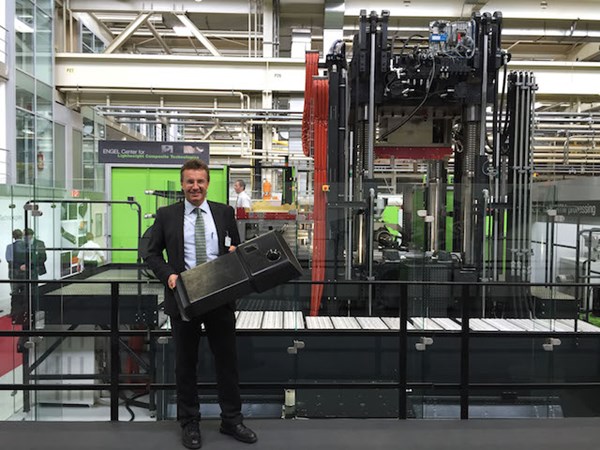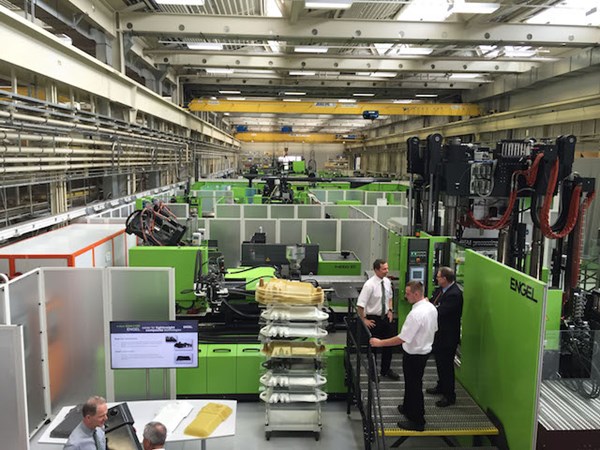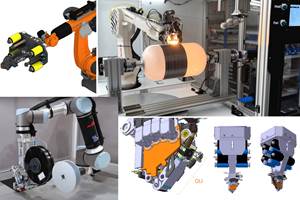Engel: Full speed ahead on composites R&D
CW attended the Engel Symposium 2015 and visited its Technology Center for Lightweight Composites in St. Valentin, Austria.

Peter Egger, director of the Engel Center for Lightweight Composites​.
Injection molding manufacturer Engel recently hosted more than 3,000 customers and partners at its facilities in St. Valentin and Linz, Austria. I attended the symposium that took place in picturesque Austria and spent some time at Engel’s Technology Center for Lightweight Composites, which was established in 2012 at St. Valentin. Engel showcased the work being done at the technology center, while at the same time, calling attention to the importance of collaborative research in composites R&D.
Together with its partners Fill (Gurten, Austria) and Hennecke (St. Augustin, Germany), Engel demonstrated the HP-RTM process with a generic test component on an Engel v-duo 3550/1100 machine during the symposium. Hennecke is its partner for polyurethane processing; Fill specializes in the production and processing of fiber-reinforced composite preform elements. Thanks to the close cooperation with its partners, Engel can also provide highly integrated system solutions—including the production of preforms—for the production of FRP components from a single source.
Peter Egger, director of the Engel Center for Lightweight Composites, told me that the center allows the company to work on the intensive interdisciplinary development of fiber composite technology together with partner companies and universities.
Engel recently annouced that it is currently building a v-duo 3600 machine for the Open Hybrid Lab Factory in Wolfsburg, Germany. Engel is a founder member and sponsor of the research center initiated by Volkswagen in 2012 and supported by Germany’s Federal Ministry of Education and Research. With clamping force of 36,000 kN, the Engel v-duo 3600 is the largest machine in its series. One machine in the same clamping force class is installed at BMW’s Landshut factory, where large structural components of fiber-reinforced plastic composites are manufactured using the HP-RTM process.
Engel developed its v-duo series specifically for fiber-reinforced processing. In contrast to the presses conventionally used in such applications, Engel vertical machines have a relatively small footprint, the company says. The height and weight of the machines are much lower, which reduces the foundation building overhead. The clamping unit can be accessed from all four sides instead of just two due to a very high rigidity as well as the parallelism of the mold mounting platens.
Currently, the company is focused on solutions for the automotive market. (Egger did say they are also interested in both aerospace and electronics). With regards to lightweight design in the automotive market, new processes as well as new materials must be developed for automotive manufacturing.
“One of the biggest challenges is design—there are a lot of nice products, new materials and very good processes, but still a very big gap on how to design the parts for composites,” he said.

Each day, Engel stays focused on driving the industrialization of the composites process forward.
“The speed of development and the speed of getting composites in the marketplace is still quite low if you look at how long people are working with it,” Egger said. “The goal is go from handwork to serial production. The advantage of Engel is that we are more used to serial work and the quality control implementation that is part of the injection molding machine process.”
Related Content
Carbon fiber, bionic design achieve peak performance in race-ready production vehicle
Porsche worked with Action Composites to design and manufacture an innovative carbon fiber safety cage option to lightweight one of its series race vehicles, built in a one-shot compression molding process.
Read MoreReinforcing hollow, 3D printed parts with continuous fiber composites
Spanish startup Reinforce3D’s continuous fiber injection process (CFIP) involves injection of fibers and liquid resin into hollow parts made from any material. Potential applications include sporting goods, aerospace and automotive components, and more.
Read MoreThe next evolution in AFP
Automated fiber placement develops into more compact, flexible, modular and digitized systems with multi-material and process capabilities.
Read MoreCombining multifunctional thermoplastic composites, additive manufacturing for next-gen airframe structures
The DOMMINIO project combines AFP with 3D printed gyroid cores, embedded SHM sensors and smart materials for induction-driven disassembly of parts at end of life.
Read MoreRead Next
Next-gen fan blades: Hybrid twin RTM, printed sensors, laser shock disassembly
MORPHO project demonstrates blade with 20% faster RTM cure cycle, uses AI-based monitoring for improved maintenance/life cycle management and proves laser shock disassembly for recycling.
Read MoreUltrasonic welding for in-space manufacturing of CFRTP
Agile Ultrasonics and NASA trial robotic-compatible carbon fiber-reinforced thermoplastic ultrasonic welding technology for space structures.
Read MoreCutting 100 pounds, certification time for the X-59 nose cone
Swift Engineering used HyperX software to remove 100 pounds from 38-foot graphite/epoxy cored nose cone for X-59 supersonic aircraft.
Read More












